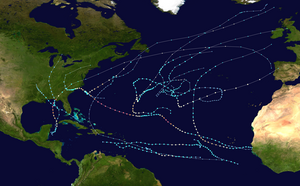| 2018 Atlantic hurricane season | |
|---|---|
 Season summary map | |
| Seasonal boundaries | |
| First system formed | May 25, 2018 |
| Last system dissipated | October 31, 2018 |
| Strongest storm | |
| Name | Michael |
| • Maximum winds | 160 mph (260 km/h) (1-minute sustained) |
| • Lowest pressure | 919 mbar (hPa; 27.14 inHg) |
| Seasonal statistics | |
| Total depressions | 16 |
| Total storms | 15 |
| Hurricanes | 8 |
| Major hurricanes (Cat. 3+) | 2 |
| Total fatalities | 172 total |
| Total damage | > $50.526 billion (2018 USD) |
| Related articles | |
The 2018 Atlantic hurricane season was the third in a consecutive series of above-average and damaging Atlantic hurricane seasons, featuring 15 named storms, 8 hurricanes, and 2 major hurricanes,[nb 1] which caused a total of over $50 billion (2018 USD) in damages and at least 172 deaths.[nb 2] More than 98% of the total damage was caused by two hurricanes (Florence and Michael). The season officially began on June 1, 2018, and ended on November 30, 2018. These dates historically describe the period in each year when most tropical cyclones form in the Atlantic basin and are adopted by convention.[2] However, subtropical or tropical cyclogenesis is possible at any time of the year, as demonstrated by the formation of Tropical Storm Alberto on May 25, making this the fourth consecutive year in which a storm developed before the official start of the season.[3] The season concluded with Oscar transitioning into an extratropical cyclone on October 31, almost a month before the official end.
Although several tropical cyclones impacted land, only a few left extensive damage. In mid-September, Hurricane Florence produced disastrous flooding in North Carolina and South Carolina, with damage totaling about $24 billion. The storm also caused 54 deaths. About a month later, Hurricane Michael, the first tropical cyclone to strike the United States as a Category 5 hurricane since Hurricane Andrew in 1992, left extensive damage in Florida, Georgia, and Alabama. Michael caused approximately $25 billion in damage and at least 64 deaths. Since Michael reached Category 5 status, 2018 became the third consecutive season to feature at least one Category 5 hurricane. Hurricane Leslie resulted in the first tropical storm warning being issued for the Madeira region of Portugal. Leslie and its remnants left hundreds of thousands of power outages and downed at least 1,000 trees in the Portuguese mainland, while heavy rains generated by the remains of the cyclone caused 15 deaths in France. The storm left approximately $500 million in damage and 16 fatalities.
Most forecasting groups called for a below-average season due to cooler than normal sea surface temperatures in the tropical Atlantic and the anticipated development of an El Niño. However, the anticipated El Niño failed to develop in time to suppress activity, and activity exceeded most predictions.
- ^ Saffir–Simpson Hurricane Wind Scale. National Hurricane Center (Report). Miami, Florida: National Oceanic and Atmospheric Administration. May 23, 2013. Archived from the original on January 11, 2014. Retrieved July 1, 2019.
- ^ "Hurricane Season Information". Frequently Asked Questions About Hurricanes. Miami, Florida: NOAA Atlantic Oceanographic and Meteorological Laboratory. June 1, 2018. Archived from the original on September 17, 2021. Retrieved August 12, 2022.
- ^ Forbes, Alex (June 1, 2022). "No Atlantic storms develop before hurricane season for first time in seven years". Macon, Georgia: WMAZ-TV. Archived from the original on January 28, 2024. Retrieved August 12, 2022.
Cite error: There are <ref group=nb> tags on this page, but the references will not show without a {{reflist|group=nb}} template (see the help page).